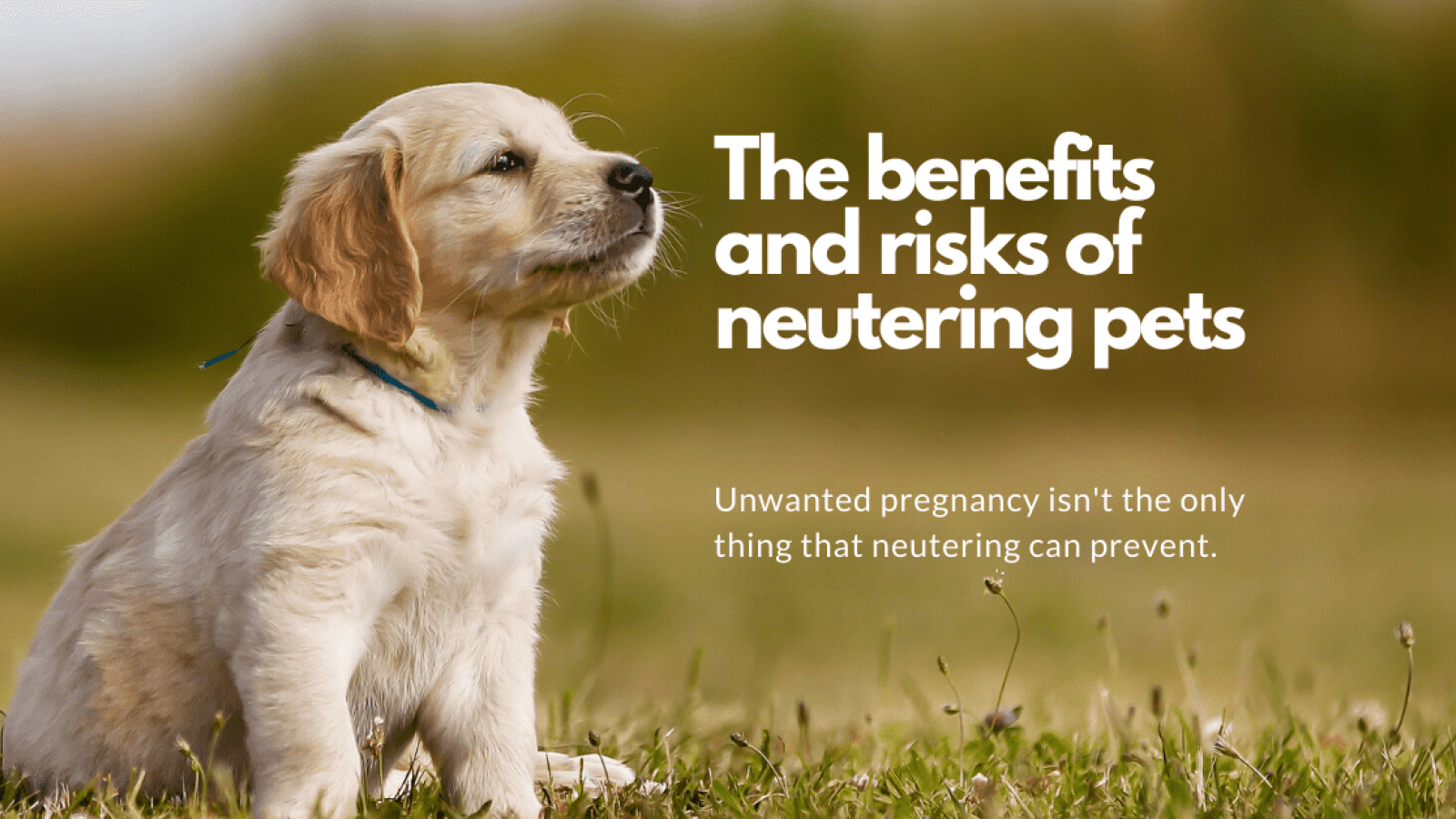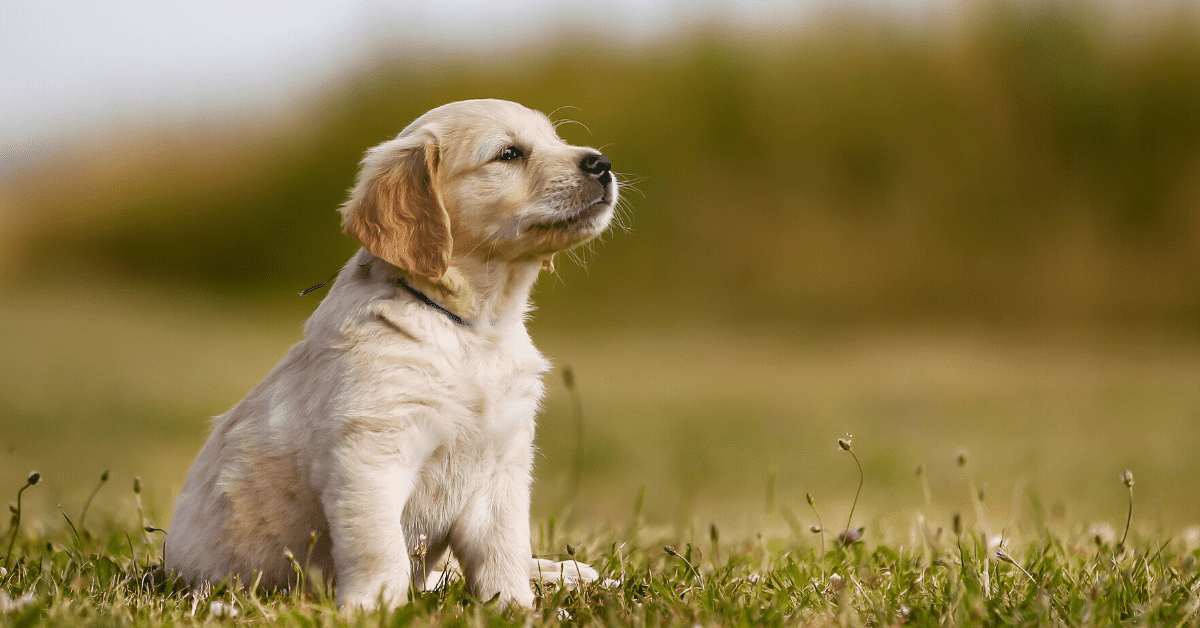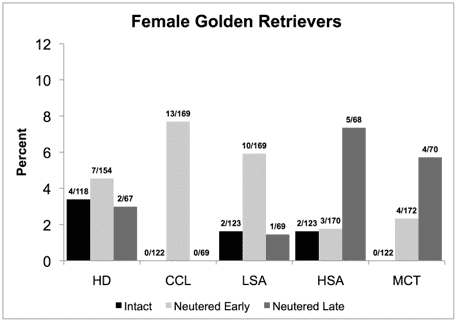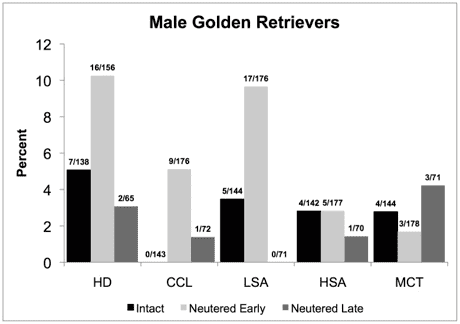Will Not Having A Femal Dog Fixed Casue The Dog To Get Cancer
The benefits and risks of neutering pets
Posted: by Mia Rozenbaum on 25/02/20
More on these Topics:

Text to become here...
 For decades, veterinarians and animal associations have promoted the benefits of neutering to prevent unwanted litters. Every year, hundreds of thousands of unwanted dogs and cats, including puppies and kittens, are euthanised.
For decades, veterinarians and animal associations have promoted the benefits of neutering to prevent unwanted litters. Every year, hundreds of thousands of unwanted dogs and cats, including puppies and kittens, are euthanised.
By having your canis familiaris or cat sterilised, you do your part to forbid the birth of unwanted puppies and kittens. Spaying and neutering prevent unwanted litters, help protect against some serious health problems, and may reduce many of the behavioural problems associated with the mating instinct. Removing a female dog or cat'southward ovaries eliminates heat cycles and generally reduces the unwanted behaviours that may lead to owner frustration.
Removing the testes from male dogs and cats reduces the breeding instinct, making them less inclined to roam and more content to stay at dwelling. Spaying an animal also has wellness benefits: from preventing uterine infections, prostatic hyperplasia, or chest, ovarian or testicular cancer which are fatal in near 50% of dogs, to avoiding unwanted behaviours such as aggressiveness, fleeing, earthworks, marking. But at present there is evidence that sterilisation can have some negative impacts on health.
Overall, the data is complex and inconsistent, but a growing body of research seem to incriminate neutering as a cancer risk. Nonetheless, this isn't a clear cutting relationship. Many factors need to be taken into consideration when looking at the relationship betwixt interventions such as sterilisation and cancer. These can exist the historic period when spayed, the brood, body size and sex.
All studies seem to be sure of one affair, the trends are not universal. Some cancers well-nigh certainly occur less oft post-obit neutering, and others about certainly occur more often. This link is likely to have a genetic component, manifested by the tendency of certain breeds to develop certain types of cancer. Unlike dog breeds also have different overall cancer risk.
As almost 1 in three dogs volition develop testicular tumour in their lifetime. Castration, the removal of the testicles, plainly takes away that hazard. For mammary tumours, the removal of the ovaries and the sexual hormones has a positive effect on tumour development, and the earlier, the better. Dogs spayed before their starting time, second or third heat cycle have a 0.v%, viii% and 26% chance respectively of developing mammary tumours. Tumour gamble in the mammary glands in unabridged dogs is therefore college than in neutered animals. Moreover, small breeds were at a higher risk of developing tumours of the mammary gland and the endocrine glands than big breeds. So hormones seem to clearly impact tumour development merely non ever in a bad way.
A recent publication took into account many factors and found that neutering appears to reduce the chance of adenocarcinomas, the most common type of cancer plant, specially in females. Since over 60% of the adenomas/adenocarcinomas are found in the sexual organs, this primarily relates to chest cancer, as previously stated, which occurs much more ofttimes in intact females than in neutered females or males.
Other types of cancer, outside the genital organs either showed no difference in hazard with neutering or appeared to exist more than common in neutered animals for ane or both sexes. Females were at a lower risk for haemangioma/ haemangiosarcoma and squamous prison cell carcinoma compared with males, while they had a 33.7% higher risk for adenoma/adenocarcinoma overall. And unsurprisingly, age seemed to increase tumour run a risk.
In Golden Retrievers the dogs seem to be more than at risk of developing tumours in various locations other than the sexual organs, simply when the information was scrutinised, again disparities started showing upward. Time of neutering seemed to have an important impact on cancer development as early neutering seems to accept a more than negative touch than a afterwards operation. But this result cannot exist extrapolated to other breeds of dogs.


Percentages and number of cases over the total sample size for each neutering status grouping; intact and neutered early on or tardily for male person/female person Aureate Retrievers (i–8 years old) diagnosed with hip dysplasia (HD), cranial cruciate ligament tear (CCL), lymphosarcoma (LSA), hemangiosarcoma (HSA), and/or mast cell tumor (MCT) at the Veterinary Medical Teaching Hospital of the University of California, Davis, from 2000–2009.
Interestingly, the issue of neutering condition on tumour development seem to be partly dependent on the examination method, specifically on whether the creature was expressionless or alive at the fourth dimension of diagnosis. Neoplasm incidence in post-mortem samples seem to be higher in neutered than in unabridged dogs, suggesting bias through investigation of mammary glands and testes in ex-vivo materials. This might explain why an important amount of studies seem to correlate neutering to cancer development. It is of import to factor in collection method when examining studies.
So yes, some studies seem to point in the direction of neutering every bit having a cancer causing effect, just when scrutinised, these studies also mostly focus on very specific cases, and putting the study into context. Also the time of neutering should be considered, and is rarely informed. The best way to identify real trends is to compare data from different studies, oftentimes involving different populations (ages, breeds, geographic locations, etc.) and study methods (clinical patients, cancer registry studies, pathology lab studies, insurance company data, etc).
So for now, the advantages of neutering cats and dogs seems to outweigh the possible increase in the gamble of the animal developing cancer.
REFERENCES :
https://www.sciencedirect.com/science/article/pii/S0021997516300500
http://skeptvet.com/Blog/2016/11/evidence-update-neutering-and-cancer-risk-in-dogs/
https://avmajournals.avma.org/doi/full/10.2460/javma.231.11.1665?url_ver=Z39.88-2003&rfr_id=ori%3Arid%3Acrossref.org&rfr_dat=cr_pub%3Dpubmed&
https://raleighncvet.com/surgery/spaying-neutering-prevent-cancer-illnesses/
https://world wide web.sciencedirect.com/scientific discipline/article/abs/pii/S0195561614000916?via%3Dihub
https://www.theatlantic.com/science/archive/2019/07/dog-neutering-wellness-risks-for-certain-breeds/594355/
https://onlinelibrary.wiley.com/doi/total/10.1111/j.1476-5829.2007.00126.x?casa_token=3KlCkZBYZc4AAAAA%3A0fpBSylvcfqccAWHlcHWr7evMOZp-Td1LYi3CT7ulTMr1wAlmImxJFkMfw4jk7J49YlMB5POspHa2w7k
https://europepmc.org/commodity/med/16761625
https://www.ncbi.nlm.nih.gov/pmc/articles/PMC3572183/
Last edited: three March 2022 11:37
Back to News
Will Not Having A Femal Dog Fixed Casue The Dog To Get Cancer,
Source: https://www.understandinganimalresearch.org.uk/news/neutering-and-cancer-the-good-the-bad-and-the-ugly
Posted by: williamswict2001.blogspot.com


0 Response to "Will Not Having A Femal Dog Fixed Casue The Dog To Get Cancer"
Post a Comment